Learning Objectives
The goal of this chapter is to enable you to do the following:
- Describe psychology’s place as an academic discipline within the context of the sciences
- Describe how application of the scientific method has resulted in the development of technologies that have transformed the human condition
- Describe the historical development of the current definition, goals, and methods of psychology
- Describe how non-experimental and experimental research procedures relate to the issues of internal and external validity
- Describe how the assumption of determinism and possibility of self-control relate to human potential
- Provide examples of frequency and intensity measures of thoughts, feelings, and behaviors
Introduction to the Science of Psychology
Assumptions
There are things I think I know, things I think I might know, and things I know I don’t know. I have learned that it is important to be able to tell the difference. In this book, I am trying to share some of the most important things I think I know about psychology. What I mean by important is that I think you will find many of these things interesting and some helpful in contemplating human potential and living your life under your unique human conditions.
I don’t know you personally but I am going to try to communicate based on certain assumptions. My assumptions are usually inferences based on things I think I know. I think I know that you just completed reading this sentence. Another thing I think I know (but am not as certain of), is that you are a student or someone interested in psychology. Accordingly, I will try to relate the material to college’s and life’s usual demands (e.g., passing objective and essay examinations; time management, problem-solving, health and weight control, etc.).
Mighty oaks from tiny acorns grow.
In their attempt to understand their world and the meaning of their existence, humans increasingly rely on the scientific method to understand nature. All sciences are interested in establishing cause and effect relationships that apply under natural conditions. Over the past 400 years, there have been enormous advances in the physical, chemical, and biological sciences. This has resulted in applied technologies that have transformed the planet and the human condition.
This book describes the results of application of the scientific method to understanding the behavior of individual animals including humans. As a science, psychology studies how genetics (i.e. heredity or nature) and the environment (i.e. experience or nurture) influence covert (i.e. thinking and feeling) and overt behavior. That is, psychology assumes that the same principles that apply to acorns and oaks apply to human beings. Exposure to sunlight, water, and fertilizer determine the development of acorns. Throughout subsequent chapters we will see how different environmental variables influence human development. Traditionally, psychology has been broken down and introductory textbooks organized according to distinct content areas. In this book, these content areas are separated into those heavily influenced by genetics (biological psychology, sensation, motivation); those heavily influenced by experience (learning and cognition); and those emphasizing nature/nurture interactions (lifespan development, personality, social psychology, and maladaptive behavior). As will be observed as you advance through these content areas, the scientific method has been successfully applied to complex and important behavioral phenomena. Just as with other sciences, the establishment of cause and effect relationships has enabled the development of applied strategies.
The idea of potential is a paradox. It implies absolute limits and enormous possibilities. It is simultaneously pessimistic and optimistic. Potential can result in good or harm, creation or destruction. To consider psychology the science of human potential requires recognizing and accepting these contradictions. Every acorn has the potential to become a mighty oak but not every acorn will achieve that potential. Every healthy human child has enormous potential but not every child will achieve their potential.
The first paragraph of the serenity prayer, usually attributed to Reinhold Niebuhr, states:
God grant me the serenity
To accept the things I cannot change;
Courage to change the things I can;
And wisdom to know the difference.
The college experience can be described as encouraging students to consider the meaning of their lives within the context of lives that have been lived and lives that could be lived. This requires knowledge of history and culture to inform one regarding the likelihood of accomplishing change and imagination to consider other possibilities. The hope is that such knowledge and imagination will be applied wisely throughout one’s life.
An amusing distinction related to the serenity prayer describes three types of individuals: those that make it happen (i.e. demonstrate courage), those that watch it happen (i.e. are passive), and those that ask “what happened” (i.e. are clueless). The messages conveyed by the serenity prayer and this distinction relate to human potential. Those that are informed and active in considering options and making decisions are more likely to achieve their potential than those less informed or passive.
The Importance of Grades and Performance Standards
Do you think people have traits? Do you think some students are industrious and others are lazy? We will discuss such issues in Chapter 9 (Personality). I think I know that if you are a student, you care about the grades you receive on exams. It is very difficult to be accepted into a university if you did not do reasonably well on exams. It is unlikely that you would have done well on exams if you didn’t care how you performed. Similarly, you will not excel at anything in life unless you are motivated to meet acceptable standards of performance. Parents and teachers probably tried hard when you were young to get you to care about how you performed in and out of school. We know that with respect to school grades, this often happens early. The reason we know is that research has demonstrated that some Head Start (Edlund, 1972), first-grade, and second-grade students (Clingman & Fowler, 1976) do better on IQ tests if they are given extrinsic rewards (e.g., candy or trinkets) for correct answers . Other students perform to the best of their ability without the extrinsic rewards. We will discuss such issues in Chapter 4 (Motivation & Emotion). Getting students to care about how they performed was obviously very important. Do you think research conducted with rats and pigeons can help us develop procedures to get children to care about their performance in school and on other tasks? We will review related questions later in this chapter and examine some of the practical implications of animal research in Chapter 5 (Direct Learning).
Edlund, and Clingman and Fowler are the first researchers cited in this book. Many more will follow. Complete references are listed alphabetically at the end of the book. You are encouraged to consult the original references whenever you have questions concerning a particular finding or conclusion or wish to obtain additional information. We live in a world where we are continually exposed to information designed to influence our beliefs and opinions. One of the most important skills you can acquire as a student or in life is the ability to determine what constitutes a credible basis for believing something is true.
The Importance of Knowing When You Know and When You Don’t Know
Even experienced students and adults sometimes have difficulty determining when they understand something and when additional (or more likely, different) preparation is required. One of the ways in which I will try to help you determine whether you understand material is by inserting essay questions at the end of major sections. Some of these questions can be answered through memorization. Others will require a level of understanding beyond memorization. They will require integrating key concepts and applying them so that you will appreciate the basis for our current understanding of psychological issues. Test yourself by writing out your answers to these questions. I suspect you will sometimes find that even though you thought you understood the material after you read it, you have difficulty providing a clear, complete, and accurate answer. If this is the case, you will know that it is necessary to review the material until you are able to provide such an answer. For example, can you answer the following question?
The Structure of College and Types of Knowing
Psychology is an academic discipline (i.e., body of knowledge based upon accepted, standardized methods). Before we consider the structure of the psychology curriculum and how it relates to the organization and content of this book, we will consider where psychology fits within the usual college curriculum. College students are asked (sometimes required) to take courses in many academic disciplines. Many of these courses are taught by departments housed in administrative units known as Arts and Sciences. Psychology is almost always housed within colleges of Arts and Sciences encompassing many disciplines not designed to prepare students for specific career paths (e.g., Art & Music, History, Philosophy, Physics, etc.). This is in contrast to pre-professional academic units such as Education, Business, and Nursing.
The psychology major prepares students for graduate education and psychology related vocations such as clinical, counseling, school, and industrial psychology. The American Psychological Association website includes a substantial amount of information concerning career opportunities in psychology (http://www.apa.org/careers/resources/guides/careers.aspx). Another very helpful psychology career website is: www.drkit.org/psychology.According to the Bureau of Labor Statistics the job growth for psychology till 2026 is projected to be faster than the average for other occupations.
Over the years, many students have asked me why they have to spend so much of their first two years taking courses in Arts and Sciences (often referred to as core courses). They indicate the desire to just take courses in their favorite department (often referred to as a major). I often respond to such questions by referring to the famous picture based on the poem, The Blind Men and the Elephant (Saxe, 1872).
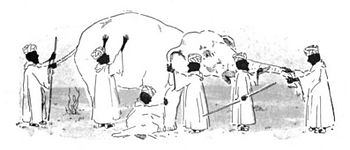
Figure 1.1 Blind men and an elephant
Often students are asked to take courses in the arts (e.g., history, literature, art or music, philosophy), “natural” (i.e., perhaps more accurately referred to as “laboratory”), and social and behavioral sciences. Psychology, which may be defined as the scientific study of individual thought, feeling, and behavior, is usually included in the last category with disciplines such as Sociology and Political Science. It is usually not included in the next-to-last category with disciplines such as Biology, Chemistry, and Physics even though, as we shall see, much of its research is conducted in laboratories. The arts, natural sciences, and behavioral sciences may be considered blind men with the elephant representing the human condition. Each perspective is attempting to help you place your life within a broader context of time, place, and ideas. History attempts to base its understanding on artifacts obtained over different time periods. Literature attempts to capture the essence of the human condition in different types of creative narratives (e.g., novels, plays, poems). Art and music provide different types of examples of human creativity. Philosophy applies reason and logic to questions regarding the meaning of life. Sometimes students believe since they have already taken similar courses in high school they will be repeating the same material. We have long known from the cognition literature (see Chapter 7) that repetition improves memory (Ebbinghaus, 1885). Also, you will probably find that your college professors ask you to do more and provide more difficult assignments, even when treating the same material.
Early History of Psychology
Wilhelm Wundt is given credit for founding the discipline of psychology at the German University of Leipzig in 1879. It is there and then that the first laboratory exclusively dedicated to psychological phenomena was established. Prior to then, research that would be considered psychological in nature was conducted in physics and neurology laboratories. Examples would include Fechner’s (1860) psychophysics research investigating just noticeable differences on sensory dimensions and Helmholtz’s studies of vision conducted in the 1850s and 1860s (translated into English in 1924).

Figure 1.2 Wilhelm Wundt
Wundt (1873, 1896) defined psychology as the scientific study of conscious experience or, as some prefer, the study of the mind. His thinking was influenced by the chemist Dmitri Mendeleev, who formulated the periodic chart of elements. Wundt felt the goal of psychology should be to determine the fundamental elements of conscious experience, a sort of “mental chemistry.” His research suggested that the basic elements were images, sensations, and affective states (i.e., emotions) and that these had the attributes of quality, intensity, and duration. Wundt relied upon introspection (i.e., looking inward) as the exclusive methodology. He felt that, with extensive training, individuals could be taught to make objective judgments regarding the attributes of what they were covertly (i.e., privately) experiencing. Thus, a subject might be placed in front of a desk and asked to describe the intensity and duration of her/his images, sensations, and emotional experiences.
Inevitably, other scientists interested in psychology reacted to different aspects of Wundt’s original approach to the discipline. In 1890, Harvard’s William James published his classic textbook The Principles of Psychology introducing much of the content and organization of subsequent introductory psychology textbooks. Edward Titchner, a student of Wundt’s who established a laboratory at Cornell University, made distinctions between Wundt’s and James’ approaches to psychology, labeling the former as structuralism and the latter as functionalism (1898, 1899). The University of Chicago’s James Angell responded (1903, 1907) with the functionalist perspective on the same distinction. This perspective was influenced by Charles Darwin’s (1859) contributions regarding natural selection. Titchner and Angell argued that Wundt’s original goal of analyzing conscious experience did not adequately emphasize the adaptive role played by the mind in survival. The major functionalists, in addition to William James and James Angell, included John Dewey and Harvey Carr of the University of Chicago. In addition to arguing for broadening the goals of psychology, they proposed expanding the methodology beyond introspection to include active experimentation in which the effects of different variables could be investigated.

Figure 1.3 William James
In 1910, Max Wertheimer, a doctorate in psychology, was studying the perceptual experience of apparent movement later labeled as the phi phenomenon. He had purchased a toy stroboscope that subjectively produced the impression of continuity from appropriately timed presentations of still photos (similar to projection of filmed still images in a movie theater) and was searching for subjects to investigate the effect. A friend provided laboratory facilities at the Frankfurt Psychological Institute and introduced him to Kurt Koffka and Wolfgang Kohler, two outstanding post-doctoral students to serve as subject colleagues (Kendler, 1987). This union resulted in the formation of the distinct psychological perspective called Gestalt psychology (Kohler, 1929). The German word gestalt is usually translated as “organized whole” and the catchphrase “the whole is greater than the sum of its parts” succinctly summarizes the major message of this approach. Gestalt psychologists disagreed with structuralism’s goal of analyzing conscious experience. The phi phenomenon was used to exemplify this message. Analyzing the phenomenon into distinct presentations of single photos was inappropriate. They argued that to do so, misrepresented and actually destroyed the very essence of what we perceive. When describing conscious experience, one had to work at the level of complete organized units. For example, to describe a desk in terms of the visual and tactile sensations it produces, does not capture the meaningful whole we perceive.

Figure 1.4 Max Wertheimer
It has been quipped that sciences advance when one scientist stands on the shoulders of another and psychology advances when one psychologist stomps on the head of another. The originator of this comment could have had John Watson in mind. Watson was trained as a functionalist at the University of Chicago and upon graduation accepted an excellent position at Johns Hopkins, where he remained for 12 years. Publication of his Psychological Review article, “Psychology as the Behaviorist Views It” (1913), resulted in no less than a permanent transformation of the discipline. Unlike the functionalists and Gestalt psychologists, Watson considered Wundt’s approach to have been a false start. His manifesto called for a change in the definition, goals, and methods of psychology. Watson reasoned that if psychology were to be considered a natural science the subject matter had to meet the three criteria of being observable, testable, and replicable. Since conscious experience cannot be independently verified by any means, testable questions could not be formulated and results could not be replicated. Watson limited the subject matter of psychology to observable behavior and defined the discipline as the science of individual behavior. The scientific method would be applied to the goal of prediction and control of observable behavior.
Watson’s behaviorism was particularly critical of introspection as a method of inquiry. Not only was introspection inherently subjective, making independently verifiable replication of results impossible, it was a reactive procedure that unnecessarily limited the discipline’s subject matter. A reactive procedure is one in which the observational procedure affects the results. Watson argued that the act of introspecting necessarily altered one’s conscious experience. That is, the research findings obtained while introspecting would only apply under circumstances where an individual is engaged in introspection. This is not ordinarily the case. Also, since only reliable verbal human beings could accurately describe their introspections, it was impossible to study abnormal populations, children, or other animals as subjects.

Figure 1.5 John Watson
Psychology Today
Each of the major early schools contributed significantly to the way psychology is currently practiced. Working backward, it is recognized that our scientific observations are limited to observable behavior (Skinner, 1990). Indeed, just as in other sciences, psychology’s subject matter is expanded with the development of new instruments. Astronomy benefited from the invention of the telescope, biology from the microscope, and psychology from such innovations as the IQ test, personality tests, reaction timer, galvanic skin response (GSR), Skinner-box, electroencephalograph (EEG), magnetic resonance imaging (MRI), computerized recording of behavior, and so on.
Current psychology has profited from the wisdom of the Gestalt psychologists as well. Indeed, a hard lesson was learned when it was realized that many conclusions reached regarding human memory based on the study of nonsense syllables (e.g., GUX) did not apply to meaningful words and sentences. For example, it has been demonstrated that the individual letters in words are processed simultaneously rather than sequentially (Adelman, Marquis, and Sabatos-DeVito, 2010). This means the word is processed as a “Gestalt’ (organized whole), not separate letters.
Functionalism continues to be influential within psychology. Indeed, evolutionary psychology, an approach consistent with major themes of this book, has emerged recently as a unifying perspective for such distinct content areas as biological psychology, learning, and social psychology (Confer, Easton, Fleischman, Goetz, Lewis, and Buss, 2010).
By virtue of being first, Wilhelm Wundt was able to define, state the goals, and develop the methodology of psychology. We have seen that this advantage had its cost since it provided others the opportunity to make suggestions and offer criticisms, not always in a collegial manner. Still, the most important components of structuralism have been incorporated within current practice. The fact that Introduction to Psychology textbooks practically all include chapters on perception, learning, and cognition demonstrates continued interest in conscious experience. We do not directly observe people perceive, learn and think. These topics must be studied in an inferential manner based upon behavioral observations. That is, people behave as though they perceive, learn, and think.
Introspection continues as a methodology for acquiring data in the form of self-report with the inherent limitations of such data being recognized and studied in their own right. Wherever possible, confirmatory measures other than self-report are frequently obtained. For example, in studies designed to reduce cigarette smoking, subjects are often required to provide carbon dioxide measures in addition to cigarette per day self-reports.
Research Methods in Psychology
Scientific Explanation
As mentioned previously, by explanation we usually mean a statement of cause and effect. Scientists refer to potential causes as independent variables and the related effects as dependent variables. Different sciences are defined by the dependent variables of interest. That is, physics studies the effects of different independent variables on matter and energy. Biology studies the effects of different independent variables on life processes. Psychology studies the effect of different independent variables on the behavior of individual animals.
All sciences assume that nature is lawful and that if you study nature systematically the underlying laws can become known. This assumption is referred to as determinism and is not today considered controversial with respect to physics, chemistry, and biology. We look to these disciplines to provide answers regarding questions regarding how nature works and benefit from technological advances resulting from scientific understanding. The assumption of determinism with regard to human behavior, however, is considered very controversial by those believing we possess freedom of the will. I hope to reduce or eliminate the controversy by pointing out that the logical opposite of determinism is not freedom of the will, but non-determinism. That is, the logical opposite of the assumption that nature is lawful is that nature is not lawful. Everyone, including those believing strongly in freedom of the will, acts as though behavior is lawful. We (usually) stop at red lights and proceed when they turn green. We (usually) take turns listening and speaking. We (usually) show up for class on time, etc., etc. None of this would be true if we did not expect others to act in a predictable manner. Predictability, implying lawfulness, can only be true within a deterministic system.
Let us now consider what psychology considers a lawful explanation of human behavior. We start with a couple of scenarios. Imagine that you are in a classroom and a person your age enters, walks over to a wall and starts banging their head against it. Then the person takes a seat and starts talking out loud to someone else, although no one else is present. Someone from the university counseling center enters the room and concludes these behaviors occur as the result of schizophrenia. Another person your age enters the classroom, congested and coughing. Someone from the university health services concludes the person is experiencing these symptoms as the result of influenza.
These two scenarios appear very similar. An individual’s behaviors or physical symptoms are explained by reference to an underlying condition or illness. However, the first example constitutes an example of a pseudo- (i.e., false) explanation whereas the second example could fulfill the requirements of an adequate explanation. Why is that? Both explanations involve terms that are difficult to pronounce and spell. What makes influenza “better” than schizophrenia? Remember, by explanation we mean a statement of cause and effect. This requires a separate observable potential cause (independent variable) and effect (dependent variable). In the case of influenza, a specific bacteria or virus can be detected through the appropriate tests. The term influenza does not simply stand for a syndrome of symptoms. It stands for the relationship between a specific “germ” and a specific syndrome. It is possible to test and replicate the relationship between this specific germ and specific symptoms. This is not the case with the term schizophrenia which is defined exclusively on the effect (dependent variable) side (DSM 5, 2013). It is circular to explain a phenomenon with the name for the phenomenon. Why does the person behave that way; because the person is schizophrenic. How do you know the person is schizophrenic; because the person behaves that way.
As will be shown repeatedly, pseudo-explanations can be extremely problematic in psychology. For example, it is known that students’ getting out of their seats can be increased through the attention of their teacher (Allen and Harris, 1966). If you were informed that your child gets out of the seat frequently because of attention deficit hyperactivity disorder (ADHD), you might not search for an alternate explanation. Even worse, there is the potential for the development of a self-fulfilling prophecy. That is, by virtue of being labeled ADHD, others might treat your child differently, resulting in the problem behaviors increasing in frequency. Earlier, I emphasized the importance of knowing when you know something and when you do not. The possibility of accepting a pseudo-explanation is an important example. One of the most valuable lessons you can learn is when you understand a phenomenon (in psychology or otherwise) and when you do not. Be vigilant for pseudo-explanations. Always look for testable relationships between observable independent and dependent variables.
Nature/Nurture and Explanation
Many psychologists and psychiatrists are searching for the cause(s) of schizophrenia. Where do they look? Based on the influenza example, one might consider the possibility of a genetic influence or a germ. Psychologists look to nature (heredity) and nurture (the environment) for causes. The assumption is that our genes determine our total potential for development which is then realized through exposure to appropriate environmental events. An example with plants was provided by a high school valedictorian who thanked his parents, friends, and teachers for helping him prepare for life. He thanked his parents for providing water, his friends for their sunshine, and his teachers for producing so much fertilizer!
I am sure you are familiar with so-called nature-nurture controversies. For example, some suggest that heredity is more important than the environment or vice versa with respect to schizophrenia or intelligence. In technical journals, one will see reference to heritability ratios as indications of the extent to which behavior results from genetic influences. This is another controversy that I believe is best reframed, as we did with questions regarding freedom of the will. Let us combine some of the elements of the novels Jurassic Park (Crichton, 1990) and Tarzan of the Apes (Burroughs, 1914) to show how. Someone is exploring the sight where Marie Curie or Albert Einstein died and discovers a mosquito frozen in amber. It is determined that this mosquito stung the scientist while alive and it is possible to extract the DNA and clone it. A healthy, lively infant results and is given to a loving pair of gorillas to raise. Obviously, this infant’s genetic potential will never be realized in this impoverished environment (by current technologically advanced human standards). The reverse is also true. We could provide a wonderful, loving pair of human parents with a chimpanzee to raise. This, in fact, was done with the famous chimp Washoe, the hero of a wonderful book, Next of Kin (Fouts, 1997). I can guarantee you that this book will make you laugh and make you cry and that you will never think of chimpanzees in the same way. Chimpanzees share more than 98% of their DNA with humans (Pollard, 2009). Still, by human standards, Washoe does not attain many of the complex abilities that the great majority of us do as adults. That remaining 2% of DNA accounts for some very significant differences in our genetic potential.
Nature/nurture issues frequently arise in psychology. For example, to what extent is intelligence (see Chapter 7), personality (see Chapter 9), or abnormal behavior (see Chapter 11) influenced by each? Psychology studies the influences of genetics (nature) and experience (nurture) on every aspect of individual behavior. In the next section, the methods developed by psychologists to scientifically study the effects of different variables on behavior will be described.
The Scientific Revolution
It has been suggested that the most significant accomplishment of the previous millennium was the transition from relying upon personal experience or authority figures to relying upon empirical testing to understand nature (Powers, 1999). Thus legend has it that Galileo climbed to the top of the leaning tower of Pisa to drop rocks in pairs to determine the effect of the weight of objects on how quickly they fall. Familiar experiences with very light objects (e.g., paper or feathers, which are disproportionately influenced by air currents) could lead us to believe that heavier objects fall faster than light objects. Even today, most people believe this is true. However, simple tests, such as by simultaneously dropping a dime and quarter, lead to the correct conclusion reached by Galileo that the weight does not matter. This reality is confirmed when studies are conducted in vacuums eliminating atmospheric effects.
It is not coincidental that reliance upon empirical testing resulted in tremendous strides in physics, chemistry, and biology. Many of the technological advances we take for granted in our modern world (e.g., electricity, plastics, and inoculations against diseases) subsequently emerged. Figure 1.6 dramatically shows the transformation of New York City that took place over the course of the four centuries since Henry Hudson arrived there in 1609. The island was transformed from the forest it had been for hundreds of thousands of years to a modern metropolis. These spectacular feats of engineering and construction would never have been possible without the systematic application of the scientific method. The combination of science and practice has enabled us to develop powerful technologies capable of transforming our environment and way of life. Clearly, we must appreciate this powerful methodology if we are to understand our contemporary human condition.

Figure 1.6 How Manhattan Island appeared in 1609 when Henry Hudson landed there and in 2009
Scientific Questions
Not everything that can be counted counts, and not everything that counts can be counted
(Cameron, 1963)
Might a contemporary scientist be interested in determining the number of angels that could fit on the head of a pin? When I ask this question, students frequently chuckle, some seeming uncomfortable. When I ask, might a contemporary scientist be interested in determining the number of influenza viruses that could fit on the head of a pin, students usually respond “yes”, immediately recognizing the difference between the questions. Given the limitations of human senses and currently existing technologies, we are unable to observe the presence of angels and therefore to count them. However, thanks to the existence of electron microscopes we could theoretically count influenza viruses. The fact that electron microscopes did not exist until 1931 does not mean that influenza viruses did not exist or that they were not important. The scientific method is limited to questions that may be tested through empirical observation. Only then is there the possibility for replication of results, a requirement for scientific advancement. However, if the limitations of being observable, testable, and replicable are met, we know of no more reliable, powerful strategy for determining cause and effect in nature. Next, we will review the early history of psychology, considering the implications and challenges of applying the scientific method to the subject matter.
Internal and External Validity
There are two assumptions underlying the title of this book, Psychology: The Science of Human Potential. The first is that application of the scientific method has enabled us to develop reliable cause and effect relationships between specific hereditary and experiential independent variables and specific behaviors. The second assumption is that these principles apply to our potential as individuals and a species. The first of these assumptions relates to the research issue known as internal validity and the second to the issue known as external validity. Internal validity is the ability to draw cause-effect conclusions from research findings. External validity is the ability to apply cause-effect conclusions under naturalistic conditions.
It is almost universal on college campuses that the laboratory sciences occupy separate facilities from the humanities. Laboratories create isolation from many of the extraneous variables that might influence research results. They typically include extensive electrical and plumbing requirements beyond those of “chalk-and talk” classrooms. It is the emphasis upon control and precision that results in the laboratory sciences being described as “hard” in comparison to non-empirical disciplines. For example, if one were interested in replicating Galileo’s observations regarding the influence of the effect of weight on the rate at which an object falls, it is advantageous to perform the observations inside where the wind would not play a role. Laboratories also permit greater control of the independent variable and precision in the measurement of the dependent variable. Today we could create perfect spheres that differ only in weight and measure the time taken to fall any distance in millionths of a second. Despite the differences between the laboratory and external environments, we would expect the findings to continue to apply. In fact, this would constitute an empirical question that could be tested using the scientific method. Any time the findings did not apply would suggest further research to determine the cause(s). For example, fans of different sizes and power could be placed at different locations to systematically study wind effects.
Non-experimental Research Methods
Experimentation, where the researcher is able to manipulate the independent variable and control for the influence of other possible confounding variables (i.e., other potential influences on the dependent variable), is the most reliable and powerful method for determining cause and effect. However, it is not always possible to conduct experiments in psychology (or other sciences, for that matter). Sometimes, you do not have the ability to manipulate a variable. For example, one cannot “make” someone male or female, or a particular age, etc. We can only select subjects already possessing the different attributes. We do not have the power to manipulate geographic or climatic variables to see the extent to which they influence behavior. Many variables cannot be manipulated for ethical reasons. For example, we cannot systematically punish children severely to see if that is an effective technique for eliminating undesirable behavior. Indeed, some have even questioned studying the effect of punishment on the dangerously self-destructive acts of autistic children (Bettelheim, 1985). For these reasons, many in the other laboratory sciences describe psychology as “soft.” Sometimes they even question the possibility of conducting psychology as a science. The research findings described in this book attest to the fruitfulness of applying the scientific method to psychological questions. The discipline of psychology frequently applies non-experimental designs under conditions where experimental procedures are logistically impossible, prohibitive in cost, or unethical.
Frequently non-experimental studies can provide information about the relationship between variables despite not being able to demonstrate cause and effect. However, even when relationships between variables are compelling, for example when a substantial statistical correlation exists, it is still not possible to conclude cause and effect. Often there is a hidden third variable underlying the correlation. For example, it is likely there is a high correlation between the number of books in one’s home and success in school. That does not mean that by simply providing books to an individual it will improve school performance. It is likely the number of books in one’s home is indicative of a number of economic and attitudinal advantages. Still, the fact that this correlation exists is informative and could lead to an experiment to test whether there is a cause and effect relationship between the number of books and school performance.
Experimental Research Methods
Experimental procedures involve the systematic manipulation of an independent variable in such a way as to permit the demonstration of an effect on a dependent variable. Theoretically, in psychology this would involve manipulation of genetic and/or experiential independent variables to see the extent to which they influence individual behavior. In practice, due to current technological limitations with respect to “genetic engineering”, experimental psychological research practically always involves manipulation of experiential variables. Following up on the previous example, the number of books in a home would need to be systematically manipulated as described below.
Studies Comparing Groups
In psychology, group studies conforming to major statistical designs (e.g., t-tests, analysis of variance, etc.) are the most popular experimental procedures. Small-N (i.e., small number of subjects) designs are also popular and have their distinct advantages. Before describing them, we will review the rationale underlying group studies. As mentioned before, even animals of the same species (especially humans) differ from each other. The logic of group studies is that with sufficient sample sizes (i.e., the number of subjects in each group), random assignment to conditions (groups) should result in comparable averages for all subject characteristics. That is, if 200 children were randomly selected from the general school population and assigned to two conditions according to the flip of a coin, we would expect each condition to start out with approximately the same gender, racial, and ethnic composition, to be of the same average height, age, intelligence, etc. Therefore, if after manipulation of the independent variable (e.g., the number of books provided) the groups differed significantly in their academic performance, it would be possible to conclude that the number of books caused the difference rather than a subject characteristic.
The great majority of experimental research studies cited in this book are group designs. Often it is only necessary to include two groups to demonstrate an effect, one usually receiving a type of experience (often referred to as the experimental group) and the other not receiving the experience (often referred to as the control group). If the groups differ it would be concluded the experience made the difference. Once an effect has been demonstrated, subsequent research is often conducted to obtain additional information. Control groups receiving different types of experience may be included. The nature of the control groups will determine the possible conclusions one may reach. For example, someone might be interested in evaluating whether the type of book provided to children made a difference. One group could be provided books related to their academic subjects in school, another group provided with age-appropriate “classics”, and a third group with books the children themselves selected. Parametric studies are often conducted to determine how the magnitude of a variable affects the phenomenon. For example, groups of subjects might be provided with 5, 10, 15, or 20 books.
Small-N Designs
If a researcher were seriously interested in testing the hypothesis that providing free books to children improved their academic performance they would obviously recognize that the books would be of no value unless the children actually read them. They might want to test a procedure to determine if it motivated children to read the books which are provided. A group design in which some subjects received the procedure (or different procedures) and some subjects did not could be implemented. Sometimes it is difficult to obtain a sufficient number of subjects to use a group design. This is especially true when working with special populations (e.g., autistic children, the gifted, etc.) or interested in only one or a very small number (e.g., one’s own children). In these instances, it is still possible to conduct an experiment permitting one to conclude cause and effect using a small-N design. One might suspect that it is impossible to conduct a controlled experiment with such a limited sample. That is not the case. Rather than manipulating levels of the independent variable across groups of subjects, small-N designs involve manipulation on each subject.
Establishing the Baseline
Small-N designs require establishing baselines of performance prior to introducing the experimental intervention (see Figure 1.7). Fine-tuning of baseline performance is a critical step and can require many sessions. It is usually necessary to establish consistency of responding (as in the top graph) or responding trending in the direction opposite the expected intervention effect (as in the bottom graph). Although small-N designs require far fewer subjects (thus the name), they can involve similar (or greater) investments of research time due to the number of observations made during the different phases.

Figure 1.7 Fine-tuning the baseline. Consistent responding or responding in the opposite direction of an anticipated intervention effect constitutes a useful baseline.
Although the results may seem compelling, one cannot conclude cause and effect by simply following a baseline condition with an intervention (an AB design, see Figure 1.8). For example, let us say we were monitoring the number of pages a child was reading before going to bed at night. First we would try to establish consistency by putting the child to bed at the same time, keeping the length of reading sessions constant, etc. After the number of pages read each night stabilized we might introduce our planned intervention, perhaps giving “stars” for every 3 pages completed. Even if the number of pages read started to increase dramatically, it would not at this time be possible to conclude the stars made the difference. Although perhaps unlikely, it is logically possible to suggest that something else coincidentally occurred at the time the stars were introduced. Perhaps the book(s) became more interesting, or the weather changed, or the child started drinking orange juice, etc.
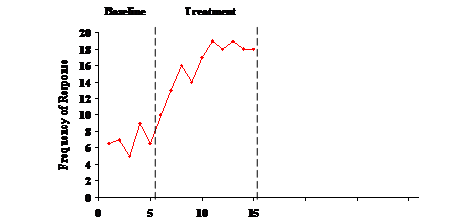
Figure 1.8 AB design.
Reversal Designs
Reversal designs (sometimes referred to as ABA, see Figure 1.9) are powerful and popular small-N procedures. In our example, once the intervention results stabilized or continued to increase for several sessions, we could discontinue providing stars. If the number of pages completed then decreased, it would be possible to conclude it was the stars that made the difference. It strains the limits of credulity to suggest that a second coincidence having the opposite effect occurred at precisely this time.
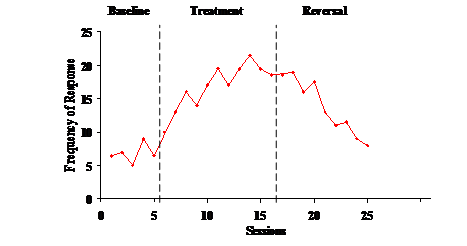
Figure 1.9 ABA reversal design.
Although reversal procedures are the mainstay of small-N designs, there are unusual circumstances where reversals do not occur or where reversing the procedures would be unethical. For example, it is conceivable that after being given stars, the child discovered the intrinsic rewards provided by reading. In that instance, discontinuing the stars would have no effect. The intrinsic rewards would be sufficient to maintain the behavior, a phenomenon known as behavioral trapping (see Figure 1.10). You might think that this is just the result one would hope for. That may be true as one who cares about the child. However, if you are a researcher attempting to establish cause and effect, you are back to square one.
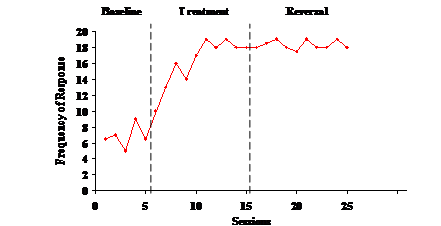
Figure 1.10 Behavioral Trapping. Naturally occurring consequences maintain the changes resulting from intervention.
One might also question the ethics of changing a procedure that was successful in increasing a child’s reading. This concern would be more apparent in research resulting in the child’s increasing a healthy behavior (e.g., wearing seat belts) or decreasing a dangerous behavior (e.g., head-banging). Clearly, in these instances, despite the requirements of science, reversal procedures should not be implemented.
Multiple Baseline Designs
For the unusual circumstances where reversals do not occur or where reversing the procedures would be unethical, variations of multiple baseline designs have been developed (see Figure 1.11). Such designs consist of replications of AB designs across subjects, situations, or behaviors. For example, Tom, Dick, and Mary might be given stars for reading. Stable baselines would be established for each child and the treatment would be introduced at different times for the three children. Instead of working with 3 different children, a similar procedure could be implemented at home at bedtime, at home with the baby sitter, and at school. The third option would be to provide stars for reading, writing, and doing math problems. In all 3 instances, if improvement occurred during the intervention phase for all 3 children, situations, or behaviors, it would be concluded that the stars were responsible.
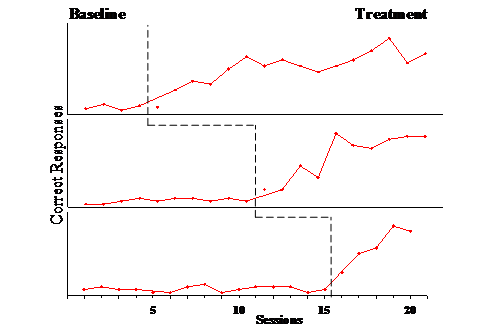
Figure 1.11 Multiple Baseline Design. Treatment is introduced at different times for different subjects, settings, or behaviors.
This concludes our discussion of the major experimental methods used to study psychology. If you become a psychology major you will be exposed to other, more complicated procedures in graduate research methods courses.
Psychology Research Methods and External Validity
The title of this textbook assumes that our current understanding of psychology informs us about the human condition including our potential as individuals and a species. This assumption is made despite the fact that some of the research findings were obtained with other animals in apparatuses developed for the laboratory. Humans share many characteristics and needs with other animals as we all do our best to adapt to our environmental circumstances. None of us had a choice about where or when we were born, or about the conditions under which we would have to survive and, hopefully, thrive. We all need to adapt to the circumstances we experience as individuals in the journey of life.
Non-Humans as Subjects
The nature of the psychological process under investigation dictates the minimal requirements of an appropriate subject. For example, in order to study perception we not only need a subject capable of sensing and perceiving the environment (see Chapter 3), but also one able to demonstrate that it perceives. The researcher must be able to observe an appropriate response to a specific stimulus. Does this mean that other, less complex animals can be used to study processes applicable to the human being? This is actually an empirical question. One could demonstrate a lawful relationship in a very simple animal (e.g., an earth worm) and test whether the same relationship could be replicated with human subjects.
This issue is similar to the doubts expressed by many at the beginning of the 20th century that vivisection of other animals could tell us anything about human biology or inform surgical technique. In fact, many of the advances in our understanding of human physiology and surgical technique occurring since then would have been impossible if such research had not been conducted. As we shall see, there is much compelling evidence that the same is true with respect to psychology.
Besides being relatively inexpensive to obtain and house, other animals do not raise the same internal validity issues intrinsic to human subjects. That is, they are closer to the perfect spheres we could use to replicate Galileo’s findings with rocks. As we saw previously, we explain differences in behavior as resulting from the interaction between hereditary and environmental variables. Laboratory animals can be purchased from the same litter, thereby having the same genes. They can even be bred or modified for specific characteristics making them ideal for specialized research projects. For example, a colleague of mine studies the learning process in rats infected with the HIV virus (Vigorito, LaShomb, & Chang, 2007). Naturally, for ethical reasons this is a study which could not be conducted with humans despite having important implications and possible beneficial applications. Laboratory animals are often obtained soon after birth and housed under restricted conditions. Obviously, they do not have the extreme cultural and other experiential histories of humans. Also, they are extremely reliable subjects. They do not require phone reminders the previous night in order to show up for a study.
The American Psychological Association has very strict ethical guidelines for the care and use of animal subjects in research. The United States government requires that an Institutional Animal Care and Use Committee be responsible for insuring that all requirements regarding feeding, access to water, climate control, and access to veterinary care are met. One learning textbook author has quipped, “It is unfortunate that there are no similar federal regulations guaranteeing adequate food, a warm place to live, and health care for the human members of our society” (Mazur, 2006, p. 13).
Often choice of species for a research subject is a matter of convenience, expense, and tradition regarding a particular topic area. Laboratory rats are frequently favored for these reasons in addition to the fact that so much is known about their characteristics based upon their research use in other disciplines (e.g., biology). Sometimes, choice of subject is dictated by species characteristics related to a particular area of interest. For example, rabbits have an extra eyelid (nictitating membrane) making them especially suitable subjects for studying the predictive learning of eyeblinks. Pigeons have exceptional eyesight in comparison to rats and are therefore favored as subjects when investigating visual perception.
Experimental Apparatus
The choice of experimental apparatus often hinges on the same issues as the choice of subject; convenience, expense, and tradition. The apparatus must permit observation of a response related to the topic area (e.g., function of part of the brain, perception of a particular stimulus, motivation, learning, etc.). Research apparatuses are considerably different from the natural environments of the species being investigated (see Figure 1.12). It is an empirical question as to whether research findings obtained under these controlled conditions apply elsewhere for these species, let alone tell us anything about the human condition. As we review the empirical findings of the psychology research literature we must constantly remind ourselves of this question.
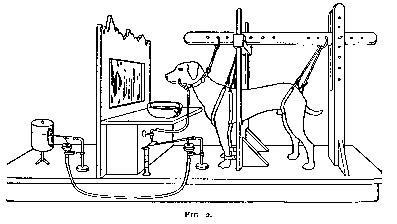
Figure 1.12 Apparatus to study learning.
All sciences must address both internal and external validity. This is especially challenging in psychology. We do not have the equivalent of perfect spheres as subjects of investigation. Rats, pigeons, chimpanzees, or people often differ from each other in significant ways. The behaviors we study may be complex and difficult to measure. The subjects and laboratory environments we use to obtain control over possible confounding variables are typically very different from the subjects or conditions of real interest. Psychologists are left with two difficult strategies to simultaneously address internal and external validity. They can try to capture the essence of the natural environment and recreate it under more controlled laboratory conditions. The other strategy is to attempt to introduce precise manipulation of the independent variable and measurement of the dependent variable in the natural environment. Throughout this book you will see many examples of the ingenuity of research psychologists in empirically investigating important issues while addressing internal and external validity concerns.
Psychology, Human Potential and Self-Control
A recurring message of this book is that the discipline of psychology uniquely applies the scientific method to study and understand the human condition. It helps us understand why we, more than any other animal, dominate this planet. The human being shares many basic needs and drives with the rest of the animal kingdom and must adapt to its environment in order to survive individually and as a species. Yet the differences in our accomplishments appear do great as to suggest qualitative differences from even our closest DNA relatives.
In the not too distant future, it is likely that communication will occur with the remaining few cultures not significantly impacted upon by current technologies. This could cause us to forget that the biological natural selection process, which continues albeit slowly, evolved over millions of years in an environment that has been significantly altered by human beings. The few remaining indigenous cultures remind us that for almost all our time on earth our everyday needs and experiences were similar to those of other animals.
In the Preface of his book documenting research conducted in the Amazon between 1990 and 1996, Politis (2007) states that his study of the Nukak “probably represents one of the last opportunities to observe a hunter-gatherer society that still lives in a traditional way.” The Nukak, living day to day, have maintained a similar lifestyle for more than 10,000 years. They lack familiarity with government, property, or money. The Nukak do not have a concept of the future and their past history is limited to a few generations. For thousands of years, the Nukak have been adapting to the demands and resources of the Amazonian rainforest. If you or I had been born under such conditions, we would be very different from the way we are and vice versa for the Colombian young adult. Human potential is developed under enormously diverse environmental conditions. Psychology is the discipline which helps us understand how you became the unique individual you are and how you can conceptualize and achieve your potential.
Determinism and Freedom in Psychology
The human condition, whether it takes place in the rain forest or a modern city, may be described as a series of choices. Moment by moment we are confronted by different possibilities. We all have the subjective experience of being free to choose as we wish, whether we are in the rain forest, desert, or modern city. How do we reconcile this feeling with the scientific understanding of the human condition implied by the assumption of determinism? Determinism implies that the subject matter of the discipline is lawful. Thus, through application of the scientific method we ought to be able to discover reliable relationships between hereditary and environmental variables and behavior. If determinism did not hold, none of the research findings described in this book would be possible. Clearly, the research findings support the applicability of the assumption of determinism to the study of psychology.
Choice and Self-Control with Pigeons
For the first of many research studies we will treat in depth, we will examine an experimental study conducted with pigeons with the surprising title “Commitment, choice and self-control” (Rachlin and Green, 1972). Do you think it is possible to scientifically study what are usually considered human characteristics such as choice, self-control, and commitment using pigeons as subjects? Do not the concerns for internal and external validity seem insurmountable? Rachlin and Green (1972) reported the findings of a study manipulating both magnitude and delay of food reward in an apparatus named a Skinner-box, after the scientist who developed it (see Figure 1.13). In a sense, they asked the proverbial question, “Which is worth more, a bird in the hand or two in the bush?” Actually, they asked which is worth more to a bird (pigeon), immediate access to 2-seconds of food or twice as much food after a 4-second delay (see bottom choice in Figure 1.14). The findings were unequivocal. Pigeons almost always chose the red (right) key associated with the small immediate reward rather than the green (left) key associated with the larger delayed reward. Anthropomorphizing, the pigeons appeared “impulsive” rather than displaying “self-control” (i.e., choosing the larger delayed reward over the smaller immediate one).
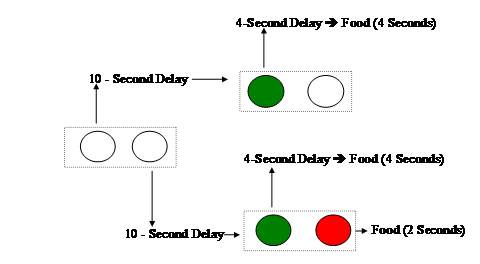
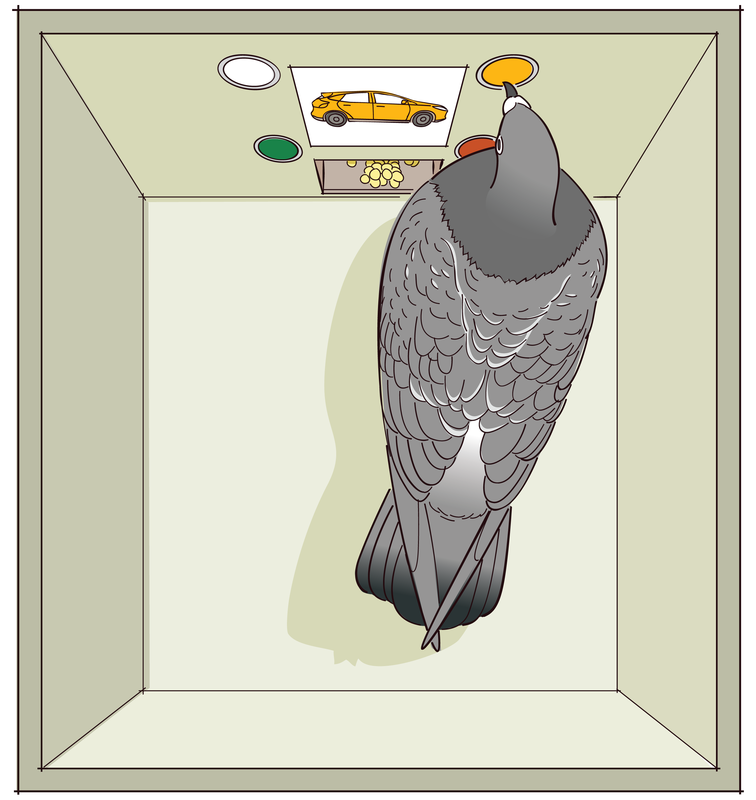
Figures 1.13 and 1.14 Procedures used to study the effect of magnitude and delay of reinforcement on choice (Adapted from Rachlin & Green, 1972). Pigeons behave “impulsively” (i.e., choose an immediate small reward rather than a larger delayed reward) when confronted with the bottom choice. However, when an initial choice response includes a delay (10 seconds in the example), pigeons are more likely to make a “commitment” (i.e., avoid temptation) to self-control (i.e., selecting the delayed larger reward).This finding, in and of itself, is interesting. However, Rachlin and Green went one step further by adding an initial choice. Pigeons were first confronted with two unlit keys (see left choice in Figure 1.9). Pecking the left key caused it to turn green after 10 seconds. At that point, the pigeon could only respond to the left (now green) key in order to receive 4 seconds of food after an additional 4-second delay. If instead, the pigeon pecked the right key, it was presented with the original choice between the left green and right red keys after the 10-second delay. The surprising finding was that the pigeons were twice as likely to press the left key as the right key.
This result is certainly counter-intuitive. We know that when confronted with the red/green choice, the pigeons strongly preferred red. Why didn’t they initially go right, resulting in the opportunity to make that same choice? Or, why didn’t they initially go right and then press red when provided the original options? The surprising interpretation by Rachlin and Green (1972) is included in the title of their article. By pressing the left unlit key, the pigeons exhibited a “commitment” to a self-control response. By responding in this manner, they were not “tempted” by the red key that was likely to be followed by a response resulting in a small, immediate reward.
Why, one might ask, is the pigeon able to act less impulsively when provided with the choice between the two unlit keys than when presented with the choice between the red and green keys? They usually say that the devil is in the details. This is an instance where the opposite appears true. Something very beneficial is revealed in a detail of the procedures used by Rachlin and Green (1972). It is easy to overlook the 10-second delay that occurred no matter whether the pigeon responded to the left or right unlit key. At that point in time, the choice is not between 2 seconds of immediate food versus 4 seconds of food after a 4-second delay. It is between 2 seconds of food after a 10-second delay as opposed to 4 seconds of food after a 14 (10+4)-second delay. Apparently a 10-second delay is an eternity to a pigeon and the “psychological” difference in a delay of 10 versus 14 seconds is far less than the difference between immediacy and 4-seconds. Since there is a long delay (10 or 14 seconds) no matter the choice between the unlit keys, the pigeon is more influenced by the magnitude of the reward (4 rather than 2 seconds) at that point in time.
One of the objectives of this book, is to encourage the development of a scientific schema as a way of evaluating scientific (and many non-scientific) questions. All sciences use similar formats in research articles. They generally consist of: introductions placing the study within the context of prior research; method sections providing sufficient detail to replicate the procedures; reporting of results and statistical analyses; discussion of the conclusions, implications, and limitations of the research. In order to assess whether you understand the Rachlin and Green study (or any other research), you should ask yourself the following: What was the question being addressed by the investigator(s)? How did the procedures enable the question to be addressed? What were the results and conclusions regarding the question? In this instance you should be able to:
Choice and Self-Control with Humans
Rachlin and Green’s findings have been replicated many times, attesting to the internal validity of the findings. That is, we know that that there is a cause-effect relationship between delay of reward and choice behavior in pigeons. The question remains, however, whether these results relate to human behavior. Walter Mischel developed the “marshmallow test” to study impulsiveness and self-control in children (Mischel and Ebbesen, 1970; Mischel, Ebbesen, and Raskoff Zeiss, 1972; Mischel and Yates, 1979; Mischel, Shoda, and Peake, 1988; Mischel, Shoda, and Rodriguez, 1989; Shoda, Mischel, and Peake, 1990). An adult placed a single marshmallow in front of a child with the instruction that it could be eaten immediately or if the child waited a certain amount of time (e.g., 20 minutes), a second one would be provided. There are many amusing and interesting You Tube videos of children undergoing the marshmallow test and implementing strategies to avoid giving in to temptation. Children who distracted themselves (e.g., by playing with a toy) were more successful than children who focused upon the marshmallow. Importantly, Mischel and his colleagues found the ability to delay gratification by 4-year olds to be significantly related to their later success in life as indicated by such measures as school performance, SAT scores, completion of college, and interpersonal competence.
It has been demonstrated that self-control can be learned. Mazur and Logue (1978) first trained pigeons to choose a large delayed reward over a small delayed reward (which is obviously easy to do). Over the course of a year the pigeons were taught to gradually adapt to increasingly shorter delays of the smaller reward. When tested a year later, the pigeons continued to exhibit a preference for large delayed rewards over small immediate ones (Logue and Mazur, 1981). These same findings were obtained with children provided similar training (Schweitzer and Sulzer-Azaroff, 1988). Given the documented importance of self-control to success later in life, it would appear prudent to incorporate such training as early in life as practicable for all children. Logue (1995) has written an excellent review of the self-control literature including applications to eating disorders, substance abuse, money management, studying, and interpersonal relations.
Many human problems occur as the result of choosing immediate small rewards rather than delayed, but more significant rewards. Examples include: eating an ice-cream sundae despite trying to lose weight; excessive drinking, threatening one’s (and others’) safety; smoking a cigarette (“slow-motion suicide” according to one Secretary of Health); hitting one’s spouse or a child because it immediately stops them from bothering you even though it creates much larger, delayed family problems; or, horror of horrors, checking out Facebook or playing video games instead of reading this book! Rachlin and Green’s (1972) results suggest that each of these problems may be addressed by committing oneself to a course of action in advance. For example: shop from a list including only nutritious, non-fattening foods; don’t drive past the ice-cream store; don’t go to the bar, or make sure you have a “designated driver”; stay away from places or events where you are likely to smoke; imagine the behaviors that upset you and rehearse a better coping strategy; use a daily planner for time-management and write the title of this book all over the pages (only kidding).
There is a substantial research literature attesting to the importance of self-control skills. It has been demonstrated that 8th-graders’self-discipline scores were more predictive than IQ for school attendance, homework time, and final grades (Duckworth and Seligman, 2005, 2006). Wills and his co-workers have documented that self-control skills reduce the risk of tobacco, alcohol, and marijuana abuse in 9-year-olds, middle-, and high-school students (Wills, Ainette, Stoolmiller, Gibbons, and Shinar, 2008; Wills, Ainette, Mendoza, Gibbons, and Brody, 2007; Wills, Walker, Mendoza, and Ainette, 2006; Wills and Stoolmiller, 2002). College students who avoid and seek alternatives to situations associated with heavy drinking have been shown to consume less alcohol (Sugarman and Carey, 2007). Thus, to a large extent, success in life appears related to the ability to resist short-term temptations in order to achieve long-term goals.
Different parenting styles will be described in Chapter 8. Mothers’ manner of instruction and level of emotional support for their preschoolers were shown to later relate to their children’s behavioral control and task persistence in school (Neitzel and Stright, 2003). Religiosity as well as the quality of parent-adolescent communication has been shown to relate to substance abuse and sexual behaviors in African American adolescents (Wills, Gibbons, Gerrard, Murry, and Brody, 2003). A major review article addressed the relationship of religiosity to self-control. It was suggested that religion promotes self-control by encouraging self-monitoring and attainment of behavioral goals (McCollough and Willoughby, 2009).
Despite the fact that we and the Nukak experience very different human conditions, there is no reason to suspect that they feel less “free” than we do in striving to reach their goals and realize their potential. From our perspective, however, we might question whether this is true. Do not the constraints of the rain forest as well as the limitations of their educational experiences result in our being able to think about things, feel things, and act in ways that they cannot? And, is not the reverse also true since we have such limited experience in the rainforest in comparison to them? Is it not true that none of us is “free” to do whatever we wish, live however we want, or become whomever we choose? Psychology provides a lens through which we may ponder the potential of the human condition from the perspective of individuals and our species.
What should I do, how should I live, and who should I become? These are the questions Haidt (2006) considered fundamental to human happiness. In a sense, one becomes freer by accepting that you are a lawful part of nature. It means that you can apply the principles of psychology to yourself in order to accomplish your own objectives. This places you more in control of your life. Is that not what we mean by freedom?
The importance of the “self” in self-control must be recognized. That is, “goals” are subjective and must be defined by each individual for her/himself. This thought is recognized in the most famous quote from The Declaration of Independence: “We hold these truths to be self-evident, that all men are created equal, that they are endowed by their creator with certain unalienable rights, that among these are life, liberty and the pursuit of happiness.” You have the ability to apply self-control techniques to influence what you do, how you live, and ultimately who and how happy you become.
Practicing Self-Control
I describe psychology as a discipline enabling humans to achieve their potential as individuals and as a species. That is clearly a bold and ambitious claim. At the end of many chapters, I will suggest you test this claim by engaging in a self-control project. As a by-product, I hope you acquire knowledge and skills which facilitate your transition to college and serve you well throughout your life. You will be asked to act like a professional psychologist. Your initial reaction might be “Is that ethical?” The answer would be “yes” if you are not only the “psychologist” but also the “client.” For years, I have been assigning self-modification projects in some of my classes. These are not only do-it-yourself projects, but also do-it-to-yourself projects. It is an instructive assignment requiring the student to observe her/his own behavior, develop a plan to change in a desired way, and assess progress. In addition to the instructional benefit, a very high percentage of the projects are successful. This is exactly what one would expect if psychology as a science was successful in discovering reliable ways of changing behavior. Note the advantage you have when you are both “client” and “psychologist.” It is logistically problematic, if not impossible, for someone else to monitor your overt behavior every waking moment. It is absolutely impossible for someone else to monitor your covert behavior at all. Despite your friend’s belief that she/he “feels your pain” or can “read your mind”, only you have direct access to your feelings and thoughts. The best your friend can do is to make inferences about your feelings and thoughts based upon how you overtly behave. You have a distinct advantage over anyone else in influencing how you feel, think, or behave.
Defining and Measuring Your Goals
Often, individuals fail to identify circumstances as requiring self-control and thereby fail to act in their long-term self-interest (Myrseth and Fishbach, 2009). Within the context of self-control, this means you would like to change the way you behave, feel, or think under specific circumstances.
The first step in self-control is to objectively describe your current and desired behaviors. Vague descriptions such as I want to be in better shape, be neater, or control my anger, etc., are not sufficient. As described earlier, psychology relies upon observable and measurable observations of behavior. Response measures typically consist of the frequency, amount, or duration of the target behavior. Following is an alphabetical listing of self-modification project response measures recently submitted by my students:
| Behavior | Response Measure(s) | Type |
|---|---|---|
| Anger | instances/week | Frequency |
| Anxiety | subjective units of distress | Amount |
| Cigarette smoking | number/day | Frequnecy |
| Cleaning room | minutes/week | Duration |
| Clutter reduction | items on desk | Amount |
| Coffee consumption | ounces/day | Amount |
| Credit card spending | dollars/week | Amount |
| Drawing | minutes/day | Duration |
| Exercise | minutes/day | Duration |
| Exercise | repetitions | Frequency |
| Knuckle cracking | times/day | Frequnecy |
| Measurements | inches | Amount |
| Meditation time | minutes/day | Duration |
| Nail & cuticle biting | length of nails | Amount |
| Piano playing | minutes/day | Duration |
| Punctuality | minutes late/instance | Duration |
| Reading | pages/week | Amount |
| Sleep | hours/night | Duration |
| Smoking | cigarettes/day | Frequency |
| Social Avoidance (shyness) | subjective units of distress | Amount |
| Social network use | times/day | Frequency |
| Social network use | hours/day | Duration |
| Soda consumption | ounces/day | Amount |
| Studying | minutes/day | Duration |
| Task completion | number/day | Requency |
| Television viewing | hours/day | Duration |
| Time management | percentage/tasks completed | Amount |
| Video game use | hours/day | Duration |
| Weight | pounds | Amount |
| Worrying | instances/week | Frequency |
| Writing | pages/day | Amount |
Collecting Baseline and Intervention Data
Once response measures have been decided, it is possible to start data collection. Fulfilling the objective of a self-control project requires being able to determine whether an intervention is working. One must therefore collect baseline and intervention data. Unlike the Small-N designs described previously, there is no need to determine cause and effect. It is not necessary to include a reversal phase or a multiple baseline. It is only necessary to demonstrate an improvement in the target behavior. The only instance where a baseline is unnecessary is when the behavior does not occur at all. For example, some students report never exercising before starting their self-control project. Recall that a good baseline is either stable or moving in the wrong direction. Once that is attained, improvement (or lack thereof) will become apparent when graphing the intervention data. Sometimes, just the act of assessing and graphing baseline data leads to improvement (Maletsky, 1974). Often my students reported that the requirement to record instances of their problem behavior focused their attention in such a manner that their behavior changed. You might recall that this would be an example of reactivity. Several experimentally verified intervention procedures will be described in Chapter 5 (Direct Learning). You might be able to derive your own procedures based upon the Rachlin and Green (1972) findings or by consulting the extensive empirical self-control literature. There will be additional suggestions concerning possible self-control projects in subsequent chapters.
